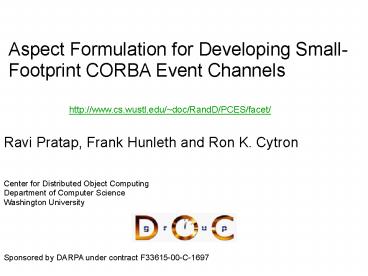Building Customizable Middleware Using Aspect Oriented Programming - PowerPoint PPT Presentation
1 / 18
Title: Building Customizable Middleware Using Aspect Oriented Programming
1
Aspect Formulation for Developing Small-Footprint
CORBA Event Channels
http//www.cs.wustl.edu/doc/RandD/PCES/facet/
Ravi Pratap, Frank Hunleth and Ron K. Cytron
Center for Distributed Object Computing Department
of Computer Science Washington University
Sponsored by DARPA under contract F33615-00-C-1697
2
Traditional Middleware Development
- First release
- Clean and well decomposed design minimal set of
features - Subsequent releases
- More features are added to the core
- As core bloats, functionality is re-factored into
features - Problems
- Programs typically need only a subset of the
features - Re-factoring can be difficult and time consuming
- Hooks need to be scattered throughout the code
- Case study
- ACE and TAO
3
Separation of Concerns with Aspects
- Concerns are logically related areas of a design
- Object Oriented Programming
- Class based decompositions
- Not all types of concerns can be decomposed
- Synchronization, memory management
- Crosscutting features and functionality
- Aspect Oriented Programming (AOP)
- Concerns are encapsulated into Aspects
/ Id EventChannelTraceAspect.java,v 1.4
2002/02/27 165658 fhunleth Exp / package
edu.wustl.doc.facet.tracing import
edu.wustl.doc.facet. import org.apache.log4j.Ca
tegory import org.apache.log4j.NDC import
org.aspectj.lang.Signature / Enabling this
aspect weaves in tracing code throughout the
event channel. The tracing is done using
the Log4J logger. A good pattern for printing
out the trace messages is "-4r txmn"
/ aspect EventChannelTraceAspect /
Get the logging category / protected
static Category cat Category.getInstance
(EventChannelTraceAspect.class) /
Application classes. / pointcut
myClasses() within(edu.wustl.doc.facet..
) !within(edu.wustl.doc.facet.EventCha
nnelAdmin.) !within(edu.wustl.doc.face
t.EventComm.) !within(Test)
!within(edu.wustl.doc.facet.Upgradeable)
!within(EventChannelTraceAspect) /
The constructors in those classes. /
pointcut myConstructors() myClasses()
execution(new(..)) / The methods of
those classes. / pointcut myMethods()
myClasses() execution( (..)) protected
void enterMethod(Signature signature)
/ Update the indentation for tracing in this
thread. / NDC.push(" ") / Log
the message / cat.debug("Entering "
signature) protected void
exitMethod(Signature signature)
cat.debug("Exiting " signature)
NDC.pop() / Prints trace
messages before and after executing
constructors. / before ()
myConstructors() enterMethod(thisJoinPoi
ntStaticPart.getSignature()) after()
myConstructors() exitMethod(thisJoinPoin
tStaticPart.getSignature()) /
Prints trace messages before and after
executing methods. / before ()
myMethods() enterMethod(thisJoinPointSta
ticPart.getSignature()) after()
myMethods() exitMethod(thisJoinPointStat
icPart.getSignature())
Advice
aspect EventChannelTraceAspect /
Get the logging category / protected
static Category cat Category.getInstance
(EventChannelTraceAspect.class) /
Application classes. / pointcut
myClasses() within(edu.wustl.doc.facet..
) !within(edu.wustl.doc.facet.EventCha
nnelAdmin.)
Aspect
Joinpoints
Code
4
A Compositional Approach Using Aspects
- Develop a simple base
- Contains minimal code common to all
configurations - Add functionality with features
- Code is introduced using aspects
- User selectable
- Results
- What You Want Is All You Get no code bloat or
performance degradation due to redundant features - Flexible and simple no need to strategize base
code
Features
Base
5
FACET
- Framework for Aspect Composition for an EvenT
channel - Modeled after features from the TAO Real-time
Event Service
Push
Push
- Features
- Payload choices
- Filtering
- Correlation
- Pull semantics
- Federation
- Policing
- Timeouts
- Event Scheduling
- RMS, EDF, etc.
Push
Event Channel
Push
Push
Supplier
6
The Event Channel Base
- Provides a basic CORBA Interrupt Service
- Contains
- IDL specifications for simple push consumers
and suppliers - No event data is passed
- push () method call takes no arguments
- Event channel forwards all events to all
consumers - No filtering
7
FACET Feature Dependence Graph
- Automatic testing and validation through build
system 9192 valid combinations out of the 221
possibilities
8
Common Event Channel Configurations
- TAO-users poll was conducted
9
Library Footprint
OctetSeq payload/Correlation
Base Only
10
Footprint Results
Key A Simple event filtering B Event
correlation C Event Set support D Event Pull
support E Octet sequence payload F Any
payload G String payload H CORBA Any events I
Calculated Event header J Event type K
Timestamp L Time to live field and
processing M Profiling support N Event
statistics counters
11
Throughput for Common Configurations
12
Feature Performance Results
Key A Simple event filtering B Event
correlation C Event Set support D Event Pull
support E Octet sequence payload F Any
payload G String payload H CORBA Any events I
Calculated Event header J Event type K
Timestamp L Time to live field and
processing M Profiling support N Event
statistics counters
13
Additional Code From External Libraries
14
Non-CORBA Contexts
- Boeings Bold Stroke architecture
- Requires complex features filtering,
correlation etc. - Needs events to be dispatched in real-time based
on various parameters - JacORB is too heavy and not decomposable
- FACET was found to be ideal for Bold Stroke
- Real-time event dispatching added through a
feature since the dispatcher is pluggable - Simple Java objects in place of CORBA objects
15
Current Work
- FACET needs to be used in wide contexts
- Make the use of CORBA optional by making it a
feature - Enable support for CORBA replacements Java RMI
for example - Challenges
- Aspects cannot be applied to CORBA IDL
- Using CORBAs standard naming conventions to
apply advice - Ensure there is no predication towards CORBA
something which currently exists
16
Conclusions
- Highly customizable CORBA event channel
- AOP is a novel and practical approach to building
customizable middleware - Footprint and throughput results support the use
of AOP techniques
17
More Information
- FACET is available from
- http//www.cs.wustl.edu/doc/RandD/PCES/facet/
- AspectJ AOP bindings for Java
- http//www.aspectj.org
- The DOC Group at Washington University
- http//www.cs.wustl.edu/doc/
18
Thanks
- Advisor - Dr. Ron K. Cytron
- Original FACET Author - Frank Hunleth
- The DOC Group at Washington University
- The audience for bearing with me !































